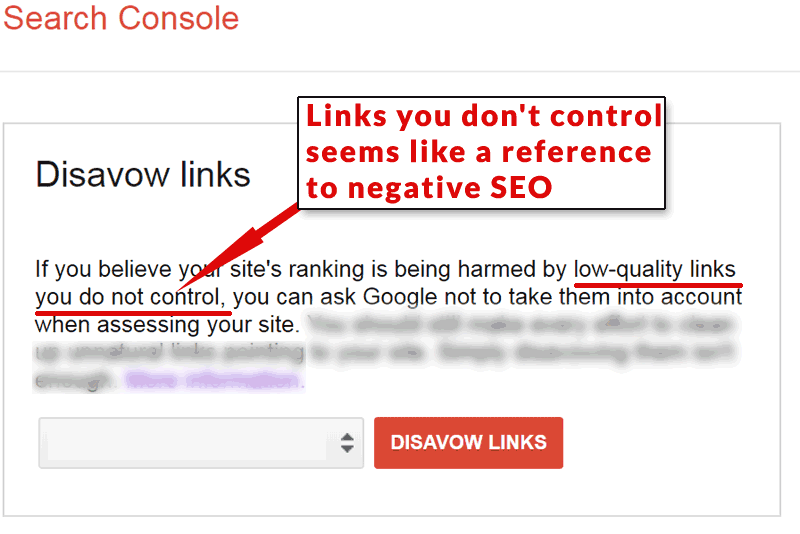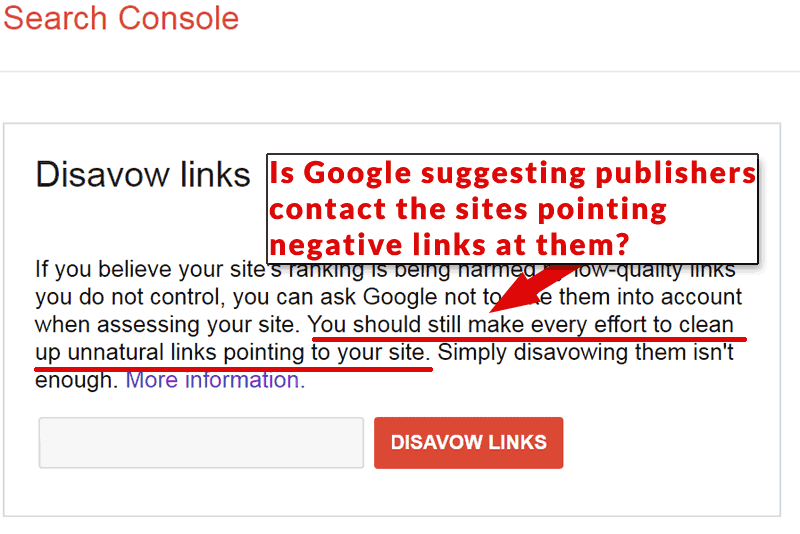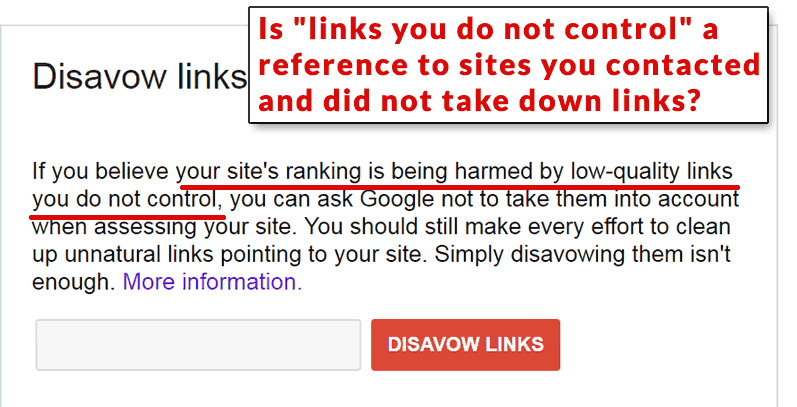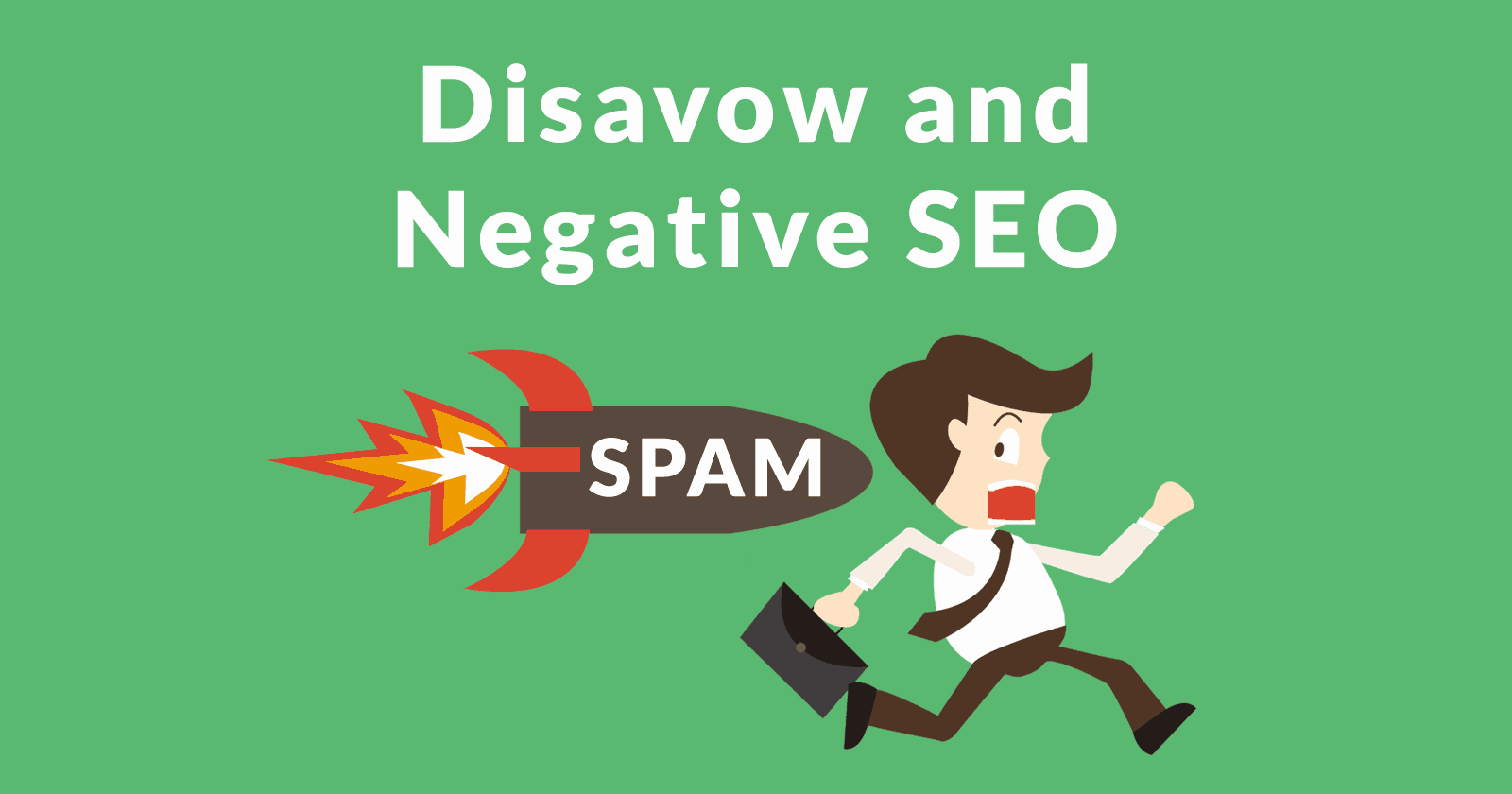The disavow tool is variously described as something Google provided in order to help it deal with negative SEO or as a way to force information about link networks from publishers that have been penalized. How the disavow tool came about is completely different. It’s important to know why the disavow tool was invented because it will help you understand the best way to use it.
Did Google Invent the Disavow Tool to Fight Negative SEO?
Google’s disavow tool almost explicitly says it’s for negative SEO. The wording chosen for the disavow tool implies that it’s for negative SEO links. The defintion of negative SEO is that they are links that someone else created toward your site, i.e. links that you do not control.
Here’s what Google’s disavow tool says:
“If you believe your site’s ranking is being harmed by low-quality links you do not control, you can ask Google not to take them into account when assessing your site.”
Although Google does not explicitly mention negative SEO, the wording seemingly implies that the tool is for removing from your backlink profile Negative SEO links, links that you don’t control.
Paid links are under your control. Negative SEO links are not under your control.

The disavow tool also says this:
“You should still make every effort to clean up unnatural links pointing to your site. Simply disavowing them isn’t enough.”

That seems to be a reference to unnatural links that a publisher created and is responsible for. That makes sense.
It certainly makes no sense to expect a publisher to contact sites that are trying to harm them with spammy negative SEO links.
What is strange is the contrast between the official Google developers page and the text on the disavow tool. Google’s official guidance on the use of the disavow tool makes a direct reference to links the publisher had a hand in creating:
…you or a search engine optimizer (SEO) you’ve hired may have built bad links to your site via paid links or other link schemes that violate our quality guidelines. First and foremost, we recommend that you remove as spammy or low-quality links from the web as possible.
Disavow Tool Does Not Reference Negative SEO?
The wording on the disavow tool is makes more sense when read to mean links that you have tried to take down but have had no success with. That’s why it makes reference to sites you have no control over (after contacting sites to take down links) and in the following sentence refers to contacting sites to take down links.
 The wording on the disavow tool makes the most sense if read within the context of using it for the purpose of removing unnatural links you are responsible for. Although the wording could be construed as a reference to negative SEO (“links you do not control”), that interpretation does not make sense within the context of the entire paragraph of content.
The wording on the disavow tool makes the most sense if read within the context of using it for the purpose of removing unnatural links you are responsible for. Although the wording could be construed as a reference to negative SEO (“links you do not control”), that interpretation does not make sense within the context of the entire paragraph of content.
While the reference to “links you do not control” sounds like negative SEO, that meaning does not fit the context of the entire paragraph. Clearly, the wording is not a reference to negative SEO.
It makes sense that SEOs and publishers would view this tool as Google’s way to deal with negative SEO. Why else would Google create a tool for users to help Google understand which links to trust? A closer reading of the wording on the tool however shows that the disavow tool is not for negative SEO.
The SEO Community Asked for a Disavow Tool
Some SEOs resent the disavow tool because they believe it is something Google forced upon the SEO community. This is a misperception based on not knowing the origin story of Google’s disavow tool.
The truth is that the disavow tool is in fact something the SEO community asked for. Google resisted providing the disavow tool on the grounds that it was not necessary because Google already knew which links were spammy.
This is different from the popular narrative that the Disavow Tool was forced on the web publishers. For some reason, many SEOs resent the disavow tool, even though the disavow tool was invented by SEOs and demanded by SEOs.
From a May 10, 2012 article about Penguin penalties by Danny Sullivan (before he worked at Google):
“I’ve seen a number of people now publicly wishing for a way to “disavow” links pointing at them. Google had no comment about adding such a feature at this time, when I asked about this.”
From a May 31, 2012 article about the need for a disavow tool Should We Disavow Links To Combat Negative SEO?:
Disavow Links
“Think of this as an open letter to Google, or just a general expression of how I feel about this conversation. …We submit things to Google all the time. We submit, XML sitemaps, robots.txt files, and we even submit reconsideration requests and report shady practices when we see them happen. …why not let webmasters be proactive?Why not submit a list of shady links which point to our site? And I don’t mean just in Webmaster Tools. I mean, webmasters could create a page for all engines to publically (sic) crawl. Call it “yoursite.com/badlinks.xml”
Ex-Googler Vanessa Fox wrote the following in SearchEngineLand:
“The idea of “disavowing links” links has been discussed for years, but Google’s recent focus on links has put it in the spotlight. At SMX Advanced, Google’s Matt Cutts said that disavowing links was something that had been asked for a lot that they were thinking of making available in the coming months.”
Google Created Disavow Tool
As you can see, the disavow tool is not something Google created on its own initiative or because it needed help dealing with negative SEO.
The disavow tool is not something Google created to force people to use.
It was something that SEOs asked for, based on their fears that the Penguin algorithm would make it easier for black hats could make sites lose their rankings through spammy links.
The disavow tool became a priority for SEOs after the Penguin Algorithm heightened the fears of negative SEO.
Google reluctantly provided the tool only because so many publishers were asking for it, but with the caveat that it ONLY be used if you received a manual penalty.
Here’s what the official Google announcement said in October 2012:
“Q: Can this tool be used if I’m worried about “negative SEO”?
A: The primary purpose of this tool is to help clean up if you’ve hired a bad SEO or made mistakes in your own link-building.Q: I didn’t create many of the links I’m seeing. Do I still have to do the work to clean up these links?
A: Typically not. Google normally gives links appropriate weight, and under normal circumstances you don’t need to give Google any additional information about your links. A typical use case for this tool is if you’ve done link building that violates our quality guidelines, Google has sent you a warning about unnatural links, and despite your best efforts there are some links that you still can’t get taken down.Q: Should I create a links file as a preventative measure even if I haven’t gotten a notification about unnatural links to my site?
A: If your site was affected by the Penguin algorithm update and you believe it might be because you built spammy or low-quality links to your site, you may want to look at your site’s backlinks and disavow links that are the result of link schemes that violate Google’s guidelines.”
Why Disavow Tool References Links You Don’t Control
The SEO community was afraid of negative SEO. They demanded that Google create a tool to help disavow what they perceived as spammy links pointing to their sites that were created by competitors.
That’s probably why Google’s disavow tool seemingly makes reference to negative SEO. That wording may reflect Google addressing the fears expressed by the publishing and SEO community:
“If you believe your site’s ranking is being harmed by low-quality links you do not control, you can ask Google not to take them into account when assessing your site.”
It was the SEO community that insisted they needed it to fight negative SEO. The wording on the tool is a reflection of the concerns that led to the tool.
It’s just a reflection of the fears expressed by the SEO community.
As you can see, Google has been consistent about discouraging the use of the disavow tool, going as far back as 2012. If you feel that you’re a victim of negative SEO, gather all the information you can. But also try to keep an open mind that maybe the reason the site is dropping is due to other factors.
I’m not denying that actual cases of negative SEO exist. I’m simply suggesting that it may be useful to keep an open mind that the cause may not be the links in order to avoid overlooking the true cause of a ranking drop.
More Resources
- Too Many Links: Strategies for Disavow & Cleanup
- Should You Disavow a Link That Sends Lots of Traffic?
- Google: Focus on Search Console Data When Disavowing Bad Links
- Google’s John Mueller on How to Use Disavow Tool – Two More Times
Images by Shutterstock, Modified by Author
Screenshots by Author, Modified by Author




